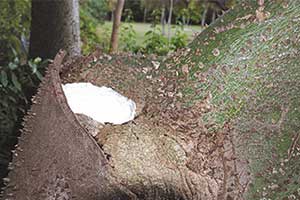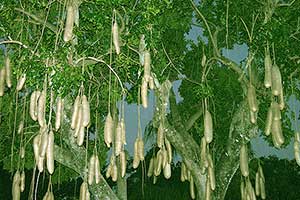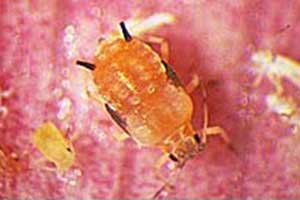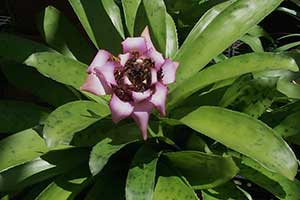
German Cockroach Control through IPM
Association of Zoological Horticulture Newsletter April 2000
This article makes recommendations based upon a successful German cockroach control program implemented by the author in a commercial animal housing facility. Using an Integrated Pest Management (IPM) approach the situation has been brought under control and the roach population is being maintained at acceptable levels.
The problems in this facility were caused by the excessive use of organophosphate insecticides for roach control over a period of several decades. As a result the facility had developed an overwhelming population of an insecticide resistant strain(s) of German cockroaches. Poor housekeeping had exacerbated the problem. Because of the author's successful experience with horticultural IPM programs (Shimonski 1991), a similar approach was taken with the roach control program. A program that stressed a minimal use of insecticides and limited as much as possible the exposure of animals, humans, and the environment to those insecticides was established.
A more common sense approach to housekeeping (in the animal facility) as well as habitat reduction for the roach population was also undertaken. The consequences of the excessive use of insecticides is summed up in a document published by The Ohio State University Entomology Extension: "To date, only the German Roach has developed a degree of resistance that presents control problems. There is a natural evolutionary process accelerated by intense selection pressure created through the use of insecticides. (The more insecticide applied the greater the selection for resistance.) Never increase dosages. For example, by killing off susceptible roaches, there remains an untouched resistant roach that becomes a larger segment of the remaining population. As a result, insecticides that at one time controlled a largely susceptible population are no longer effective against the remaining altered population and most of its descendants."
Another important factor in resistance management is the rotation of insecticide classes (Cochran 1990). The author's IPM program was based upon the use of unrelated insecticides of different chemical classes and modes of entry into the insect. It is important to attack insects at different points in their body in order to overwhelm their defense systems. These chemicals should be used in a sequential treatment pattern. A typical IPM program might consist of different chemicals being used on a monthly cycle. For example, an organophosphate can be used the first month, the second month a carbamate, the third month boric acid, the forth month insect growth regulators.
Experiments undertaken in the entomology laboratory at UCLA have shown that the principal factor affecting the efficacy of an insecticide against roaches is its repellency (Ebeling date unknown). The greater the repellency of the insecticide, the greater the chances that a certain percentage of roaches would learn to avoid treated areas before picking up lethal doses. Some of the organophosphates, i.e. Dursban and Diazinon, are very repellent. It is prudent to make non-repellent insecticides, such as boric acid, a major component of an IPM program. Repellent chemicals such as the Pyrethroids can be used as a "knock-down" to get the roaches to contact the boric acid.
One of the major components of an IPM roach control program is sanitation. Good general housekeeping that prevents roach infestations is as important as any insecticide. Food and water (and places to hide) must not be available to attract (and maintain) any of these pests. Ventilation is also an important consideration from an animal or human point of view.
There are proteins that have been isolated from roaches that have been proven to cause human allergies. "A growing body of evidence has implicated allergens derived from roaches as an important environmental factor that may aggravate asthma in sensitized persons" (O'Connor and Gold 1999). The following IPM program was developed by the author to control the roach infestation in the animal housing facility.
A monitoring program was put in place to determine the efficacy of the IPM program. Sticky pheromone traps were placed throughout the buildings where insect control was to be initiated. The traps were put in place and trapped roaches were counted once a week before the chemical control began. This allowed for a baseline of comparison during the program. The traps were to be monitored on a weekly basis and when full, replaced with new traps. The use of the monitoring traps enabled "precision targeting" (Weaver 1998).
By indicating the areas of high insect density where treatment was needed, and low insect density where little or no treatment was required, the quantity of insecticides was reduced, the efficiency of the chemicals was increased and the overall cost of the program was reduced. Housekeeping was improved. Food and water for the animals was more closely monitored. Dead and dying roaches were removed each morning and destroyed. This was very important. Often insects recover after the initial poisoning and will be the precursors to a resistant strain.
The first round of insecticide application consisted of a fipronil gel and bait. An insect growth regulator was also applied. One week after this application approximately 99% of the roaches had been killed. The low population count of roaches lasted about five weeks. An increase was noted by workers in the facility and the monitoring traps confirmed this change.
The second round was then initiated. A boric acid product was dusted in the areas where the roaches were noticed. This precision targeting had excellent results, with roach numbers being reduced once again to the low levels obtained after the first treatment. After eight months this IPM roach control program has been very successful. Since the boric acid application, only a handful of roaches have been found. The ultimate reduction of the German roaches to a manageable level on a permanent basis appears to be possible using the precision targeting method and a more holistic approach to insect control. Obviously some of the other insecticides such as the organophosphates or the carbamates may be used in the future but their use should be minimal and only occasional.
Citations:
Cochran, D.G. 1990, Managing resistance in the German Cockroach.
Pest Control Technology 18(2):56-57 Lyon, William F.
German Cockroach: HYG-2099-97, Ohio State University Extension, Entomology Fact Sheet O'Connor, George T. and Gold, Diane R. 1999,
Cockroach Allergy and Asthma in a 30-Year-Old Man, Grand Rounds in Environmental Medicine, Environmental Health Perspectives, 107(3)
March 1999 Shimonski, J. (1991), An Integrated Pest Management Plan for the Control of Phytophagous Mites (Tetranychidae) on Musoid Plants (Scitaminae). Heliconia Society Int. Bulletin. Vol. 5, No. 2
Walter Ebeling, Pests On or Near Food, Urban Entomology Chapter 6,
University of California, Riverside Entomology website
Weaver, T. (1998), Curbing Cockroaches and their Allergens. Agricultural Research Magazine, Vol. 46, No. 6
Jeff Shimonski Parrot Jungle and Gardens January 13, 2000


 About Integrated Pest Management
About Integrated Pest Management An Experiment in Arboriculture and Mosquito Control
An Experiment in Arboriculture and Mosquito Control German Cockroach Control through IPM
German Cockroach Control through IPM An IPM plan for the Control of Phtyophagous Mites on Musoid Plants
An IPM plan for the Control of Phtyophagous Mites on Musoid Plants An IPM program for growing tropical plants using cultivation techniques
An IPM program for growing tropical plants using cultivation techniques Practical IPM for the South Florida Homeowner
Practical IPM for the South Florida Homeowner